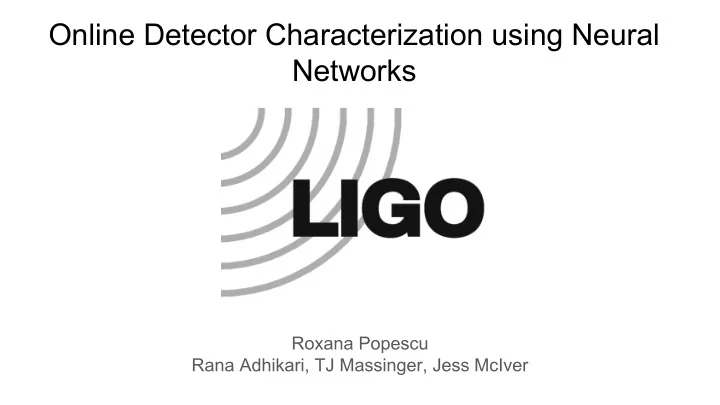

Online Detector Characterization using Neural Networks Roxana Popescu Rana Adhikari, TJ Massinger, Jess McIver
Introduction ● Data from LIGO contains noise from many sources, that need to be characterized ● Machine learning algorithms can be used to look for patterns within the data and to cluster or classify the data into different categories ● Would help determine if changes in detector sensitivity are related to changes in environment ● Looked at seismic noise for project ● Other Environmental channels: wind, acoustic
Seismic BLRMS Data
Machine Learning ● Machine learning is the field of study of programming computers so that they can learn from inputted data and improve their performance as they are given more data ● Supervised Learning vs. Unsupervised Learning ● Classification vs. Clustering
Evaluating How Well Clustering Works ● Calinsky Harabaz-Score ○ Ratio of between-clusters dispersion mean to within-cluster dispersion mean ● Comparison to recorded earthquake times ○ Add up cluster labels that occur 10 minutes before/after an earthquake ○ Add total number of cluster labels ○ For each cluster determine score , E(k), by dividing cluster labels near earthquake, N e , by total cluster labels, N t ○ E(k) = N e /N t
Determining Earthquake Times
Determining Earthquake Times
Clustering Algorithms ● Kmeans ○ Splits data into k number of clusters by minimizing distances between points and average point in cluster ● DBSCAN ○ Splits data into clusters to create clusters out of high density areas ● Agglomerative Clustering ○ A type of hierarchical clustering that builds clusters by merging data points into clusters ● Birch ○ Makes a tree data structure
Kmeans
Kmeans
Kmeans Number of Clusters Calinsky-Harabaz Cluster of Max Maximum Earthquake Score Earthquake Score Score 2 40172.1 1 0.03 3 37282.1 1 0.04 4 43960 1 0.07 5 44224.7 4 0.08 6 45616.4 3 0.08 7 46338.4 3 0.08 8 46348.9 7 0.11 9 46095.1 1 0.11 10 46746.5 6 0.13 Average 44087.1 N/A 0.08
DBSCAN Epsilon Value Minimum Number of Calinsky-Harab Cluster of Maximum Samples Clusters az Score Maximum Earthquake Earthquake Score Score 1 15 1 14.2 -1 0.0125 2 10 15 5.1 -1 0.0126 2 15 5 6.3 -1 0.0125 2 20 1 14.2 -1 0.0125 2 25 1 14.2 -1 0.0125 2 30 1 14.2 -1 0.0125 3 15 6 123.1 -1 0.0141 4 15 6 194.1 -1 0.0159 5 15 8 372.5 -1 0.0176
Include Shifted Data in Clustering A B C D E F A B C D E F 0 1 2 3 4 5 0 1 2 3 4 5 1 2 3 4 5 2 3 4 5 Shifting Data by Two Indices
Include Shifted Data in Clustering Timeshift (minutes) Calinsky-Harabaz Maximum Average Earthquake Score Average 0 44087.1 0.08 10 49251.1 0.08 30 44081.2 0.09 60 44066.1 0.08
Neural Networks ● Neural networks can be used to find relationships in data by using hidden layers of connections within the data Figures from: http://neuralnetworksanddeeplearning.com/chap1.html
Neural Networks ● We used keras with tensorflow backend ● Timeshift the data by 30 min ● Read in whether an earthquake occurs at a given time ● Use Sequential model to add four layers ● Use sigmoid activation ● Accuracy: 0.998
Neural Networks
Neural Networks
Future Work ● Obtain six months of data to use for training the neural network ● Improve the neural network ● Compare neural network results to results from clustering ● Cluster and classify DARM channel BLRMS
Recommend
More recommend